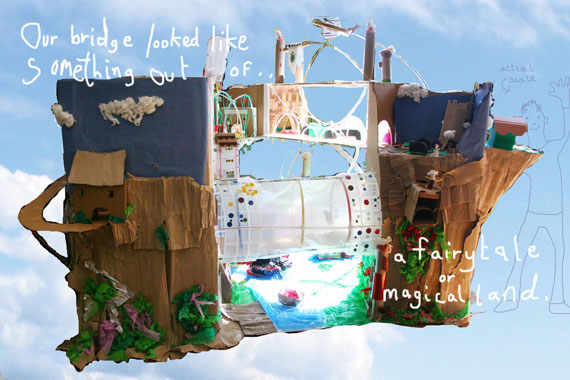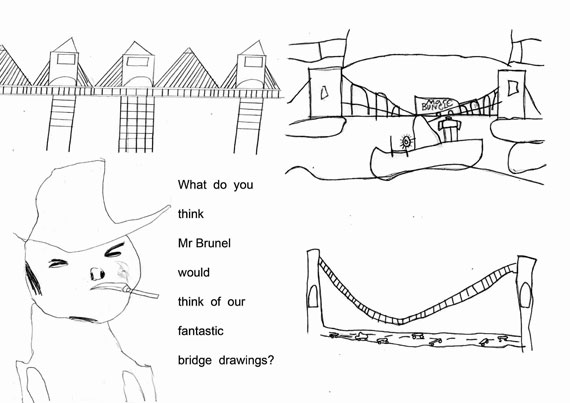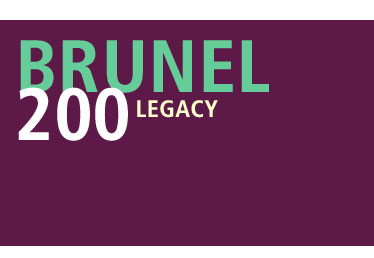|
|

| Education > Case
Study: Blaise Primary School |




100 participants – June 2006
One of
Brunel 200’s over-arching ambitions
for its education programme was to enable children to learn through
a hands-on exploration of Brunel. This created a new approach for a
set of projects which aimed to engage children who were less likely
to learn through a traditional academic approach.

Paper, Scissors, Stone,
a collective of artists specialising in the creation of 3-D carnival
structures, developed an innovative programme for Year 3 (ages 7 and
8) children based on bridge building. This included hands-on bridge
design activities and workshops in which the children experimented
with construction skills to create their own huge ‘animated’ bridge
installation. Inspired by the Clifton Suspension Bridge the children
let their imaginations fly with ideas about bridges connecting people
and places. Once their fantasy bridge had been constructed they focused
on different elements to tell stories about bridges.
A colourful and inspirational
book featuring the children’s artwork
was made by the artists as part of the documentation process. Sample
pages illustrate this page.

Linda
Trude, the link teacher at Blaise Primary, commented:
“The creativity
of the children was amazing and the making of their futuristic bridge
was a spectacular highlight during our Brunel activities. The staff and
pupils really enjoyed working with Paper, Scissors, Stone and all of
the Brunel 200 opportunities we were able to access.
The school wanted
an end product with the final design developed by the children. The partners
were well organised and they didn’t impose
their own ideas but used their expertise to devise appropriate activities
to suit the children and planned the work each night based on previous
day’s work. They got to know the children quickly and responded
on the spot to the children’s ideas. Paper, Scissors, Stone are
producing book of photographs for Brunel200 and the school. (see download
above)
The partnership appeared to work successfully through the dedication
and responsiveness of the partners and through the flexibility and openness
of the school. The finished product demonstrated the process and the
understanding of structures that the children had developed.
The pupils learnt through discussion, research and experimentation how
to make bridges sturdy. Through shorter focussed tasks, they investigated
the design and structural considerations of bridge building.
The children developed their thinking through the process of building
the work from their own ideas, thoughts and imagination. The opportunity
to work in small groups for a sustained period of time allowed a depth
and focus to the work. Although there were group activities, there was
also time for quiet thought, time to plan on their own, and time to work
on their own elements. Designs of the bridges that they drew really showed
an understanding of structure and an attention to structural elements.

The teachers were surprised by the level of imagination that was developed:
the children were reluctant initially to risk an idea but at end they
were more willing to share own ideas and not be afraid about whether
it was the right or wrong answer.
They developed an understanding that every grand design started from
small ideas and didn’t see it as work but fun. When they were working,
they were completely engaged and worked quietly with involvement. One
boy, who finds it difficult to engage, focussed on making a volcano which
built on the work that had been happening in class the previous week.
He was fully engaged and enjoyed the whole process.
One boy went on holiday to New York and was very pleased when he came
back because “wherever you go people know Bristol because of Brunel”
It made the school remember the value of Design & Technology
[as a subject area] and has encouraged them to do more focussed, sustained
practical work like this. They would like to work with Paper Scissors
Stone again, and other visitors, in order to bring in particular expertise
and different perspectives. The work was discussed with other staff during
the residency and several teachers took ideas from the smaller focussed
tasks and used them in their own classroom.
Working on Brunel 200 demonstrated
the power of focussing history around a particular character which made
the children interested on a personal level; this linked with the school’s work on BLP and learning competencies
such as perseverance and the fact that Brunel wasn’t afraid to
take a risk and get things wrong.
They found the fact that Brunel was
a local character and that his work can still be visited a good opportunity
to show the relevance of the learning and a good opportunity to get the
parents involved; they took a letter home before the holidays with the
suggestion that the parents take their children to see the Suspension
Bridge.
In future, more time for teachers’ to develop
their own ideas would be useful. Another idea is a preview afternoon
at 4.30, similar to those run by At Bristol, to find out about future
Bristol educational events. Courses are good but there are always limited
places and a whole day is sometimes difficult to take out of the classroom.”

|
|

